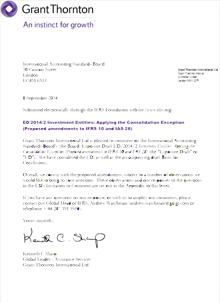-
Business consulting
Our business consulting services can help you improve your operational performance and productivity, adding value throughout your growth life cycle.
-
Business risk services
We can help you identify, understand and manage potential risks to safeguard your business and comply with regulatory requirements.
-
Data analytics center
Unlock the power of data with our expert Data Analytics team. We are a dedicated group of professionals who are passionate about harnessing the potential of data to drive informed decision-making and business growth. With our extensive knowledge and cutting-edge tools, we provide comprehensive data analysis solutions tailored to meet your specific needs.
-
Asset management
Grant Thornton’s profound experience and deep knowledge of asset management (AM) systems and registers development is based on successful implementation of large scale and complex projects in CIS region and beyond its borders.
-
Human capital advisory
Grant Thornton Armenia's human capital advisory services are designed to deliver the results you want throughout the entire lifecycle.
-
Sustainability and ESG advisory
Embark on a transformative journey with our comprehensive Sustainability and ESG services, designed to support your organization's sustainability transition and drive a meaningful impact.
-
Recovery & reorganisation
We provide a wide range of services to recovery and reorganisation professionals, companies and their stakeholders.
-
Transactional advisory services
We can support you throughout the transaction process – helping achieve the best possible outcome at the point of the transaction and in the longer term.
-
Cybersecurity
Grant Thornton will assist you with raising the level of your protection, offering services in the area of cybersecurity.
-
IFRS
At Grant Thornton, our IFRS advisers can help you navigate the complexity of financial reporting.
-
Audit quality monitoring
Having a robust process of quality control is one of the most effective ways to guarantee we deliver high-quality services to our clients.
-
Global audit technology
We apply our global audit methodology through an integrated set of software tools known as the Voyager suite.
-
Legal advisory
Legal advisory involves a wide spectrum of corporate legal consultancy ranging from incorporation and liquidation matters, legal representation, litigation, ad-hoc legal advice, provision of legal opinions to execution of due diligence and structuring deals from a legal viewpoint.
-
Business process solutions
Our business process solutions team provides a range of services to support clients of all sizes, from small to medium enterprises (SMEs) through to the largest international businesses.
-
Tax advisory
We advise our clients on all aspects of corporate tax strategy development and tax planning, tax issues arising from formation or acquisition of a company and provide an overview of local and international perspectives.
-
Energy & environment
Energy and resources markets worldwide are undergoing major changes. With growing energy demand, developments in new forms of energy and the need to invest in a sustainable future, significant shifts in these sectors are taking place all over the world. At Grant Thornton, we can help you prepare for these changes and stay one step ahead of your competitors.
-
Oil & gas
Oil & gas
-
Mining
Rising operating costs, challenging capital markets and falling commodity prices are putting miners to the test worldwide, but dynamic companies can still thrive. At Grant Thornton, we can help you make the most of these opportunities and unlock your potential for growth.
-
Private equity
We bring together international teams from corporate finance, restructuring and turnaround, taxation and assurance services that provide bespoke solutions – from investment, through the growth phase to exit.
-
Asset management
Grant Thornton’s profound experience and deep knowledge of asset management (AM) systems and registers development is based on successful implementation of large scale and complex projects in CIS region and beyond its borders.

ED/2015/5 Remeasurement on a Plan Amendment, Curtailment or Settlement/Availability of a Refund from a Defined Benefit Plan - Proposed amendments to IAS 19 and IFRIC 14
Our letter is in reponse to the IASB's Exposure Draft 2015/5 'Remeasurement on a Plan Amendment, Curtailment or Settlement/Availability of a Refund from a Defined Benefit Plan - Proposed amendments to IAS 19 and IFRIC 14.'
The Exposure Draft contains proposals relating to IAS 19 ‘Employee Benefits’ and IFRIC 14 ‘The Limit on a Defined Benefit Asset, Minimum Funding Requirements and their Interaction’.
Proposed amendment to IAS 19
The first proposed amendment addresses the accounting when a defined benefit plan is amended, curtailed or settled during a period. The Exposure Draft proposes that when the net defined benefit liability (or asset where appropriate) is remeasured as a result of one of these transactions:
- the current service costs and the net interest for the period after the remeasurement are determined using the assumptions used for the remeasurement
- an entity determines the net interest for the remaining period based on the remeasured net defined benefit liability (asset).
The Exposure Draft also proposes that the current service cost and the net interest in the current reporting period before a plan amendment, curtailment or settlement are not affected by, or included in, the past service cost or a gain or loss on settlement.
In our letter we agree with the proposals subject to some observations that we make.
Proposed amendment to IFRIC 14
The proposed amendment to IFRIC 14 addresses whether other parties’ power to enhance benefits for plan members or wind up a plan affects the availability of a refund to the reporting entity.
The Exposure Draft proposes here that the amount of the surplus an entity recognises as an asset on the basis of a future refund should not include amounts that other parties (eg the plan trustees) can use for other purposes (eg to enhance benefits for plan members) without the entity’s consent. It also proposes that an entity should not assume a gradual settlement of the plan as the justification for the recognition of an asset, if other parties can wind up the plan without the entity’s consent.
The IASB also proposes to address the interaction between the asset ceiling and the past service cost or a gain or loss on settlement. The proposals here would clarify that if a plan amendment, curtailment or settlement occurs, the past service cost or gain or loss on settlement, would be measured and recognised in profit or loss excluding the effect of the asset ceiling. Changes in the effect of the asset ceiling would be recognised in other comprehensive income, as a result of the effect of the ceiling on the updated surplus.
If accepted, the amendments would be applied retrospectively. There would however be an exemption for adjustments of the carrying amount of assets outside the scope of IAS 19 (eg where employee benefit expenses have been included in inventories).
In our letter we agree with the substance of each of the amendments, subject to some detailed comments set out as part of our responses to the IASB's specific questions.


